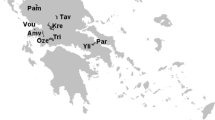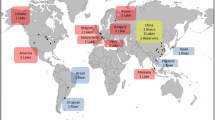Abstract
The Eastern Mediterranean and its Cilician Basin offshore waters have oligotrophic features with low nutrient concentrations, low primary production, and high water transparency. However, the wide shelf area of the Cilician Basin is subject to contaminated river inflows with enhanced nutrient loads and direct discharges of urban wastewaters of southern Turkey, leading to develop local eutrophic/mesotrophic conditions in the inner sites of Mersin and Iskenderun Bays on the Cilician Basin. For the assessment of changing trophic status of the coastal and the bay water bodies under anthropogenic pressures since the 1980s, five extensive field studies were performed in summer and winter periods of 2014, 2015, and 2016. Physical and eutrophication-related biochemical parameters (salinity, temperature, Secchi Disk Depth, nutrients, dissolved oxygen, chlorophyll-a) were measured at 65 stations in different water bodies occupying the Northeastern (NE) Mediterranean coastal, offshore areas and bays. The collected data sets were used in scaling the trophic status of the visited water bodies of NE Mediterranean coastal, offshore areas and semi-enclosed bays, using novel classification tools of Trophic Index (TRIX), Eutrophication Index (E.I.), chl-a, and HELCOM Eutrophication Assessment Tool (HEAT), developed by different experts for highly productive seas. These tools, which can successfully classify highly productive coastal water masses under human pressures, and their sensitivities have been tested for scaling of the current trophic status of the NE Mediterranean coastal water bodies being subject to human pressures. The scaling results of classical TRIX, E.I., and chl-a indices in the NE Mediterranean water masses are not sensitive enough to differentiate mesotrophic and eutrophic water bodies because these indices principally assume to have higher concentrations of eutrophication-related parameters in the least effected (reference) water bodies. The HEAT tool, which uses a site-specific “reference value” for each eutrophication-indicator, has allowed us to produce more reliable and sensitive scaling of the current trophic status of the NE Mediterranean shelf areas, even though we used only the “reference values” derived from the composite data sets. The results of the indices were compared with the HEAT tool and the actual status was assessed from observations, indicating revision requirements of the multi-metric classification tools. For this goal, scales of natural (oligotrophic) and anthropogenic (eutrophic) levels of eutrophication indicators should be determined at a sub-basin scale using long-term site-specific observations in the NE Mediterranean. The revised scale ranges of TRIX for oligotrophic, mesotrophic, and eutrophic water bodies of Mersin Bay are in line with ranges of TRIX classification tool proposed for Aegean Sea waters, which can be used to assess trophic status of the entire Eastern Mediterranean and Aegean coastal seas (surface salinity > 37.5) having oligotrophic properties in the offshore waters.





Similar content being viewed by others
References
Andersen JH, Axe P, Backer H, Carstensen J, Claussen U, Fleming-Lehtinen V, Järvinen M, Kaartokallio H, Knuuttila S, Korpinen S, Kubiliute A, Laamanen M, Lysiak-Pastuszak E, Martin G, Murray C, Møhlenberg F, Nausch G, Norkko A, Villnäs A (2011) Getting the measure of eutrophication in the Baltic Sea: towards improved assessment principles and methods. Biogeochemistry 106(2):137–156
Andersen JH, Carstensen J, Conley DJ, Dromph K, Fleming-Lehtinen V, Gustafsson BG, Josefson AB, Norkko A, Villnäs A, Murray C (2015) Long-term temporal and spatial trends in eutrophication status of the Baltic Sea. Biol Rev 92:135–149. https://doi.org/10.1111/brv.12221
Crawley MJ (2007) Classical tests. In: The R book (1st ed.). John Wiley & Sons Ltd, Chichester, pp. 279–322
Dogan-Saglamtimur N, Tugrul S (2004) Effect of riverine nutrients on coastal water ecosystems: a case study from the northeastern Mediterranean shelf. Fresenius Environ Bull 13:1288–1294
Ferreira JG, Andersen JH, Borja A, Bricker SB, Camp J, Cardoso da Silva M, Garcés E, Heiskanen AS, Humborg C, Ignatiades L, Lancelot C, Menesguen A, Tett P, Hoepffnerm N, Claussen U (2011) Overview of eutrophication indicators to assess environmental status within the European Marine Strategy Framework Directive. Estuar Coast Shelf Sci 93:117–131
Grasshoff K, Erhardt M, Kremlin K (1983) Determination of nutrients. In: Methods of seawater analysis, 2nd edn. Verlag Chemie Gmbh, Weiheim, pp 125–188
HELCOM (2009) Eutrophication in the Baltic Sea—an integrated thematic assessment of eutrophication in the Baltic Sea region. Baltic Sea Environmental Proceedings No. 115B. Helsinki Commission, 148 pp
Ignatiades L, Karydis M, Vounatsou P (1992) A possible method for evaluating oligotrophy and eutrophication based on nutrient concentration scales. Mar Pollut Bull 24(5):238–243
Kaptan MS (2013) Assessment of the trophic status of the Mersin bay waters, northeastern Mediterranean. Dissertation, Institute of Marine Sciences, Middle East Technical University
Kocak M, Kubilay N, Tugrul S, Mihalopoulos N (2010) Atmospheric nutrient inputs to the northern levantine basin from a long-term observation: sources and comparison with riverine inputs. Biogeosciences 7(12):4037–4050
Kress N, Herut B (2001) Spatial and seasonal evolution of dissolved oxygen and nutrients in the southern Levantine Basin (eastern Mediterranean Sea). Chemical characterization of the water masses and inferences on the N:P ratios. Deep-Sea Res I 48:2347–2372
Krom MD, Herut B, Mantoura RFC (2004) Nutrient budget for the eastern Mediterranean: implications for phosphorus limitation. Limnol Oceanogr 49(5):1582–1592
Menzel DW, Corwin N (1965) The measurement of total phosphorus in seawater based on the liberation of organically bound fractions by persulfate oxidation. Limnol Oceanogr 10:280–282
Pettine M, Casentini B, Fazi S, Giovanardi F, Pagnotta R (2007) A revisitation of TRIX for trophic status assessment in the light of the European Water Framework Directive: application to Italian coastal waters. Mar Pollut Bull 54(9):1413–1426
Powley HR, Krom MD, Van Cappellen P (2017) Understanding the unique biogeochemistry of the Mediterranean Sea: insights from a coupled phosphorus and nitrogen model. Glob Biogeochem Cycles 11:1010–1031. https://doi.org/10.1002/2017GB005648
Primpas I, Karydis M (2011) Scaling the trophic index (TRIX) in oligotrophic marine environments. Environ Monit Assess 178(1–4):257–269
Primpas I, Tsirtsis G, Karydis M, Kokkoris GD (2010) Principal component analysis: development of a multivariate index for assessing eutrophication according to the European water framework directive. Ecol Indic 10(2):178–183
Simboura N, Panayotidis P, Papathanassiou E (2005) A synthesis of the biological quality elements for the implementation of the European Water Framework Directive in the Mediterranean ecoregion: the case of Saronikos Gulf. Ecol Indic 5(3):253–266
Strickland JDH, Parsons TR (1972) A practical handbook of seawater analysis, 2nd edn. Bulletin of the Fisheries Research Board of Canada, No. 167, 310 pp
Tanhua T, Hainbucher D, Schroeder K, Cardin V, Álvarez M, Civitarese G (2013) The Mediterranean Sea system: a review and an introduction to the special issue. Ocean Sci 9:789–803
Thingstad TF, Krom MD, Mantoura RFC, Flaten GAF, Groom S, Herut B, Kress N, Law C, Pasternak A, Pitta P, Psarra S, Rassoulzadegan F, Tanaka T, Tselipides A, Wassmann P, Woodward EMS, Wexels Riser C, Zodiatis G, Zohary T (2005) Nature of P limitation in the ultra-oligotrophic eastern Mediterranean. Science 309:1068–1071
Tufekci V, Kuzyaka E, Tufekci H, Avaz G, Gunay AS, Tugrul S (2013) Determination of limited nutrients in the Turkish coastal waters of the Mediterranean and Aegean Seas. J. Black Sea/Mediterranean Environment Vol. 19, No. 3: 299˗311
Tugrul S, Uysal Z, Erdogan E, Yucel N (2011) Changes of eutrofication indicator parameters (TP, DIN, Chl-a and TRIX) in the cilician basin (Northeast Mediterranean). Ekoloji 20(80):33–41
Tugrul S, Yucel N, Akcay I (2016) Chemical oceanography of north eastern Mediterranean. In: The Turkish part of the Mediterranean Sea; Marine Biodiversity, Fisheries, Conservation and Governance. (Turan, C., Salihoglu, B., Ozbek, E.O and Ozturk, B). Turkish Marine Research Foundation (TUDAV), Publication No: 43, Istanbul, Turkey, pp 15–29
UNEP (1989) State of the Mediterranean Marine Environment. MAP Technical Series No. 28, UNEP, Athens
UNEP/MAP (2005) Sampling and analysis techniques for the eutrophication monitoring strategy of MED POL, MAP Technical Reports Series No. 163, Athens
Vollenweider RA, Giovanardi F, Montanari G, Rinald A (1998) Characterization of the trophic conditions of marine coastal waters, with special reference to the NW Adriatic Sea, proposal for a trophic scale, turbidity and generalized water quality index. Environmetrics 9:329–357
Yılmaz A, Tugrul S (1998) The effect of cold- and warm-core eddies on the distribution and stoichiometry of dissolved nutrients in the northeastern Mediterranean. J Mar Syst 16:253–268
Funding
This work has been supported by the Ministry of Environment and Urbanization/General Directorate of Environmental Impact Assessment, Permit and Inspection/ Department of Laboratory, Measurement and Monitoring in the context of “Integrated Marine Pollution Monitoring (2014–2016)” Project coordinated by The Scientific and Technological Research Council of Turkey-Marmara Research Center, Environment and Cleaner Production Institute. Mersin Bay surveys (2008-2013) were carried out by the support of TUBITAK (Project No: 107G066).
Author information
Authors and Affiliations
Corresponding author
Additional information
Responsible editor: Philippe Garrigues
Rights and permissions
About this article
Cite this article
Tugrul, S., Ozhan, K. & Akcay, I. Assessment of trophic status of the northeastern Mediterranean coastal waters: eutrophication classification tools revisited. Environ Sci Pollut Res 26, 14742–14754 (2019). https://doi.org/10.1007/s11356-018-2529-6
Received:
Accepted:
Published:
Issue Date:
DOI: https://doi.org/10.1007/s11356-018-2529-6




